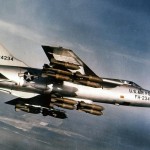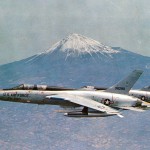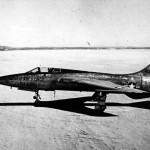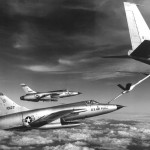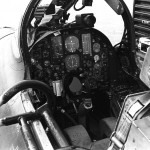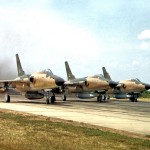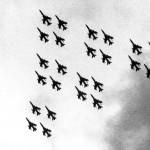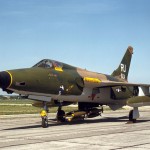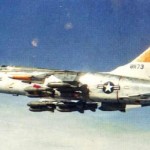
The F-105 “Thunderchief” was an American fighter-bomber capable of Mach 2 speeds that could carry more bombs than most strategic bombers of World War II.
But just because it was faster than bombers doesn’t mean it didn’t get shot down like a traditional bomber. In fact, the “Thunderchief” crashed so much that many believe its nickname, “Thud,” originated because of how often the plane hit the ground.
While the F-105 conducted thousands of sorties and did the bulk of the strike bombing missions at the onset of Vietnam, it became the only American aircraft to be pulled from active duty due to high loss rates.
The F-105 was designed as a single-seat nuclear attacker, like many of the jets unleashed in the 1950s. The jet first flew in 1955, entered service in 1958, and had its final Air National Guard units retired in 1984.
The F-105 was a speedier successor to the North American F-100 “Super Sabre” and was like-armed with bombs, missiles, and a cannon. The F-105 was exceptionally well-armed. It carried up to 16 750-pound bombs. It carried more payload than a B-17.
Out of the 833 aircraft produced, 382 — nearly half — were lost. It was bigger and less maneuverable than MiG fighters and managed only 27.5 air-to-air kills in its career. At 50,000 pounds, the F-105 was the biggest single-seat, single-engine airplane ever built.
The “D” variant of the F-105 was the most common. It featured all-weather capability, blind bombing capability, upgraded ejection seat and gun sight, and better armor than earlier models. The F-105F/EF-105F and F-105G variants were “Wild Weasel” versions used for Suppression of Enemy Air Defenses (SEAD) missions.
The F-105F was used in legendary missions that may perhaps save the airplane’s reputation in history. The two-seater hosted two Medal of Honor Recipients: Captain Merlyn H. Dethlefsen and Captain Leo K. Thorsness.
Captain Dethlefsen was awarded the Medal of Honor and Capt Kevin “Mike” Gilroy the Air Force Cross for an F-105F Wild Weasel mission on 10 March 1967. With their aircraft damaged by antiaircraft fire, the pair decided to keep heir F-105F in harm’s way, flying above Thai Nguyen until an enemy missile site was found and destroyed.

Captain Thorsness was awarded the Medal of Honor and Capt Harold Johnson the Air Force Cross for an F-105F Wild Weasel mission on 19 April 1967. The pair attempted to rescue another Wild Weasel crew that had been shot down. Thorsness shot down two enemy MiG-17s in the process and stayed in the area, acting as a decoy for enemy MiGs after he ran out of ammo.
The F-105 almost never came to fruition. The Air Force ordered the fighter-bomber to fight the North Koreans, but that conflict ended before the F-105 entered service. The Air Force reduced its 199 aircraft order down to 46 in 1953 and cancelled the program altogether months later.
The program was brought back to life in 1954, but the Air Force was looking for something more advanced. The F-105D all-weather, nuclear-capable variant filled the need, and the F-105 had life.
By 1961, the Air Force fell in love with the Navy’s F-4 Phantom II and eventually the General Dynamics F-111 “Aardvark,” and the F-105 was already past its prime.
The F-105 got its name after Republic Aviation requested “Thunderchief,” naming the airplane along the same lines as its other “Thunder” aircraft, the P-47 “Thunderbolt,” F-84 “Thunderjet,” and F-84F “Thunderstreak.”
Specifications
General
Crew: 1 (2 for C/E/F/G variants)
Length: 64 ft 4.75 in
Wingspan: 34 ft 11.25 in
Height: 19 ft 8 in
Empty weight: 27,500 lb
Max. takeoff weight: 52,546 lb
Engine: One Pratt & Whitney J75-P-19W afterburning turbojet
Performance
Maximum speed: Mach 2.08 (1,372 mph)
Combat radius: 780 mi
Ferry range: 2,210 mi
Ceiling: 48,500 ft
Rate of climb: 38,500 ft/min
Thrust/weight: 0.74
Armament
Guns: One 20 mm M61 Vulcan cannon, 1,028 rounds
Hardpoints: Five total and internal bomb bay with a capacity of Up to 14,000 lb. Could carry conventional and nuclear bombs, and AIM-9 Sidewinder and AGM-12 Bullpup missiles.
Photo Gallery
Essential Reading and More
Online Resources:
- Wikipedia
- Break-Left.org — Good narrative
- Craig Baker’s F-105 Site — Older site but great info
- National Museum of the United States Air Force Official Fact Sheet
- Heavyweight — Great stories
